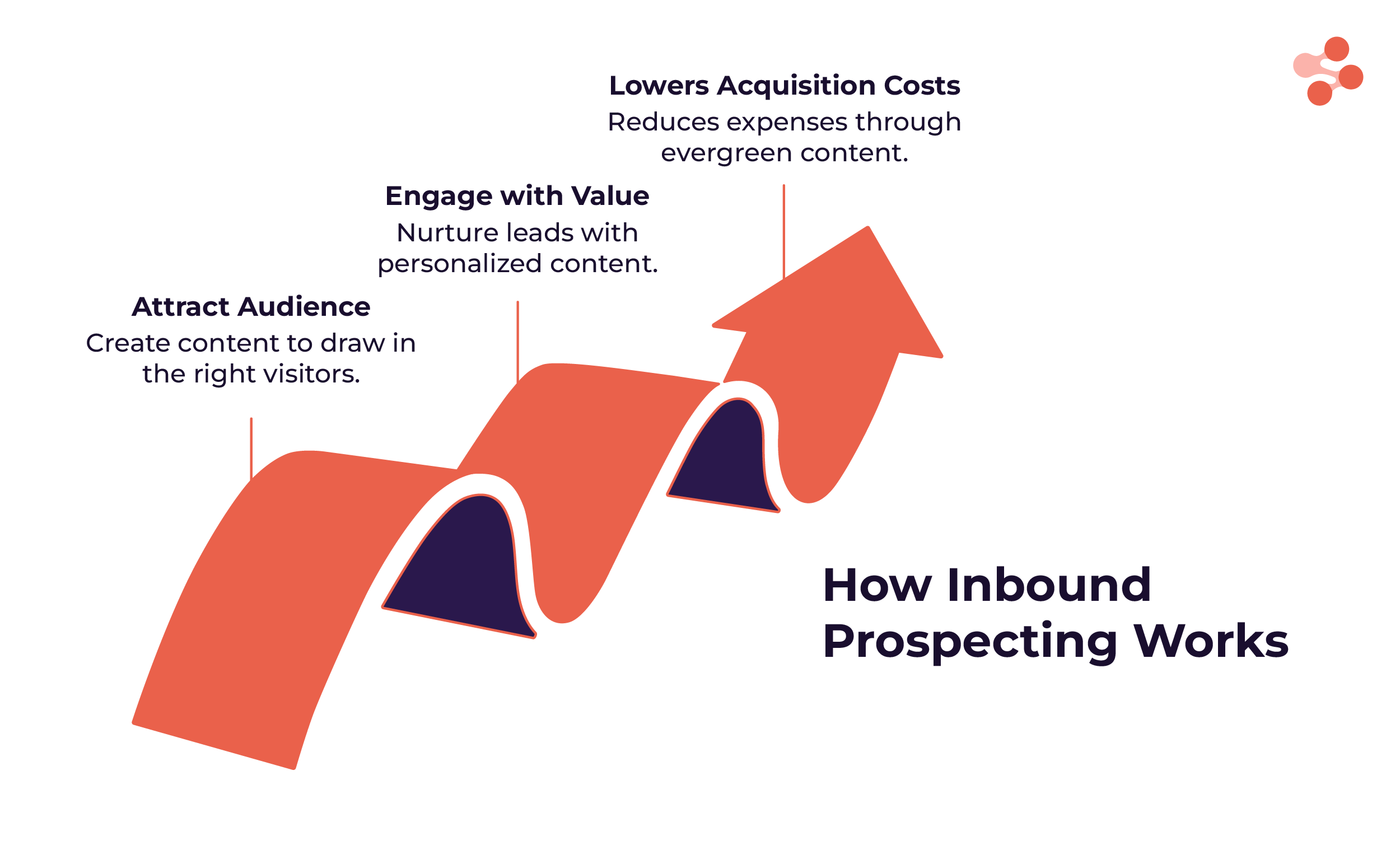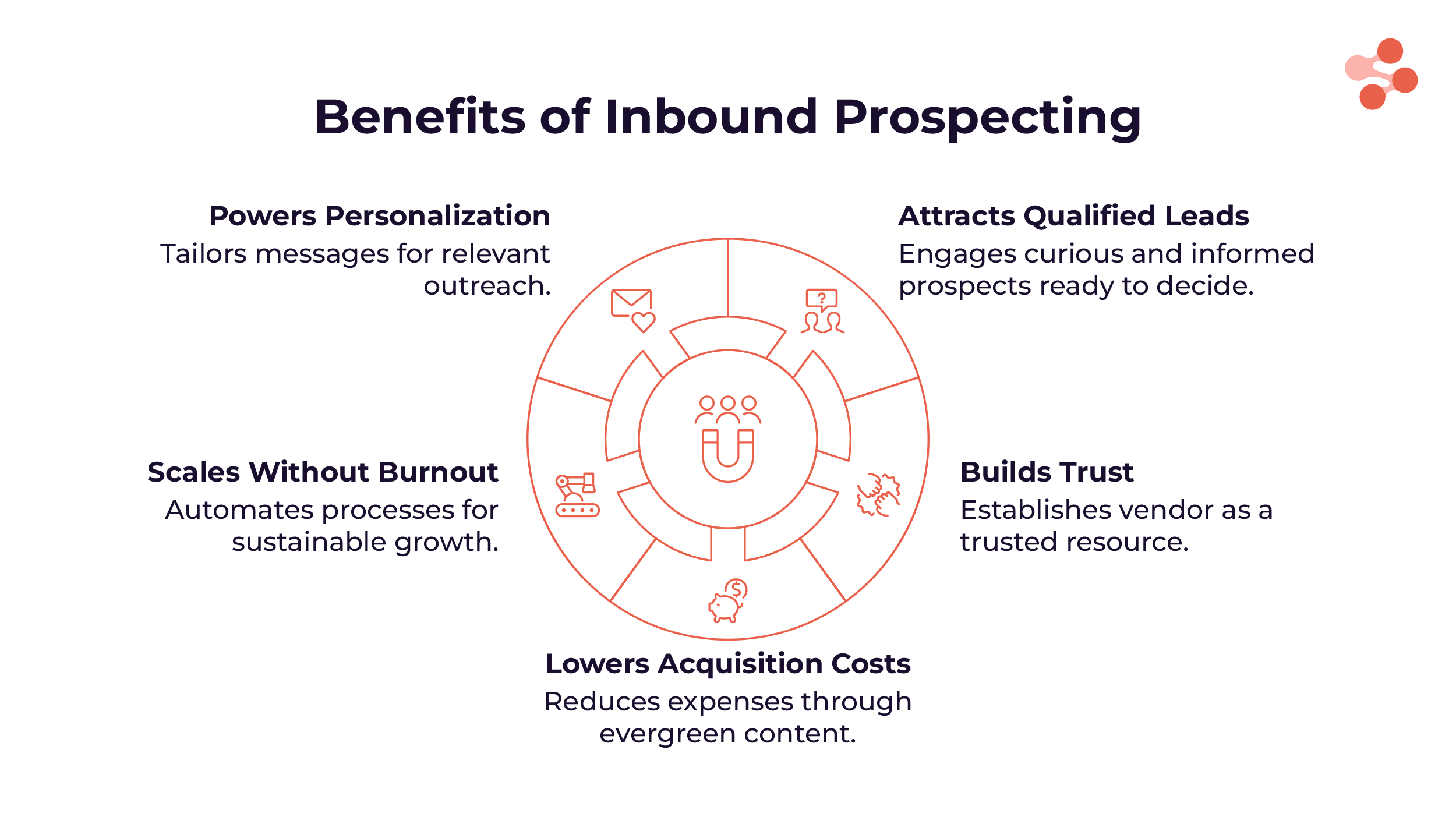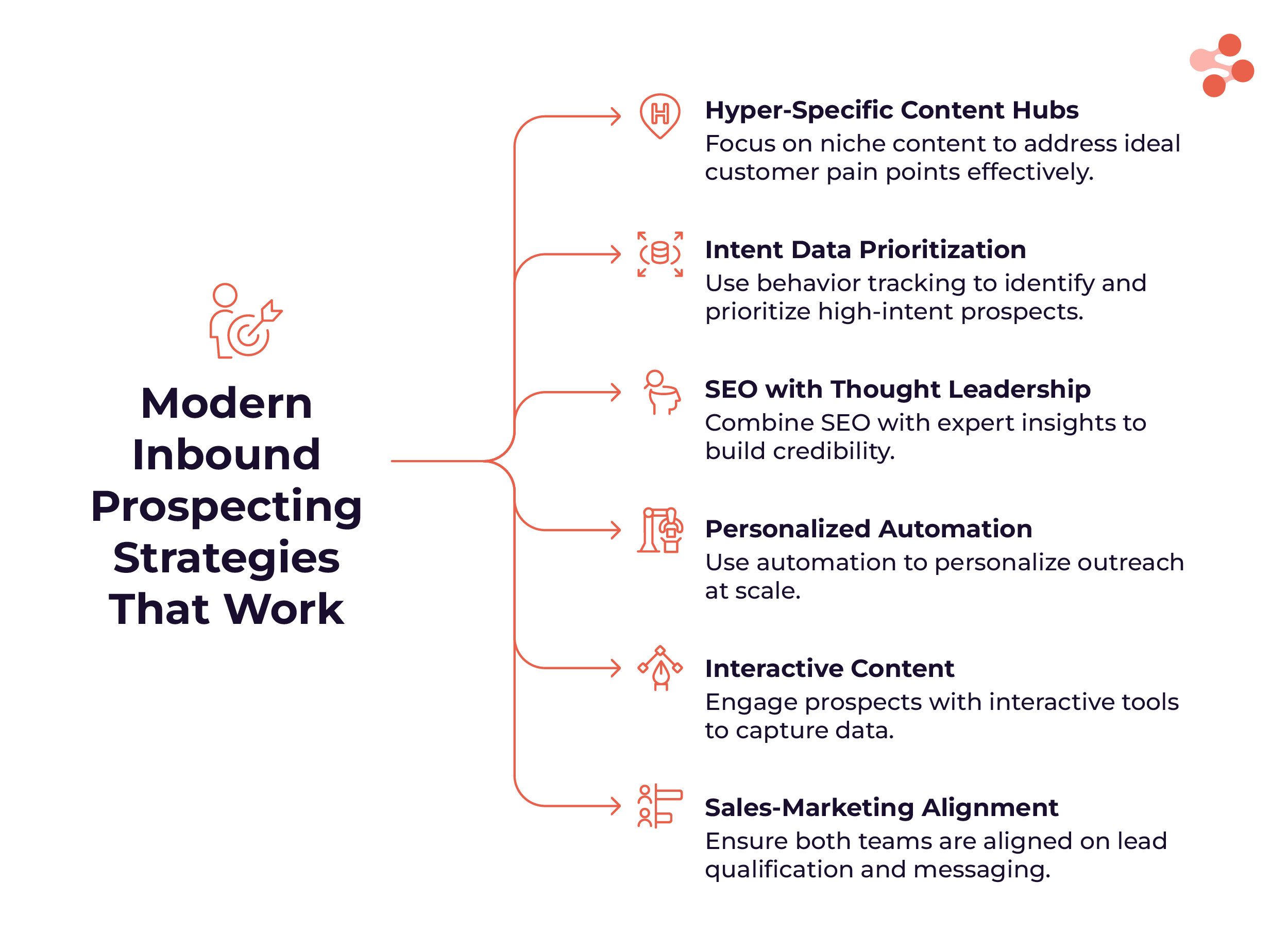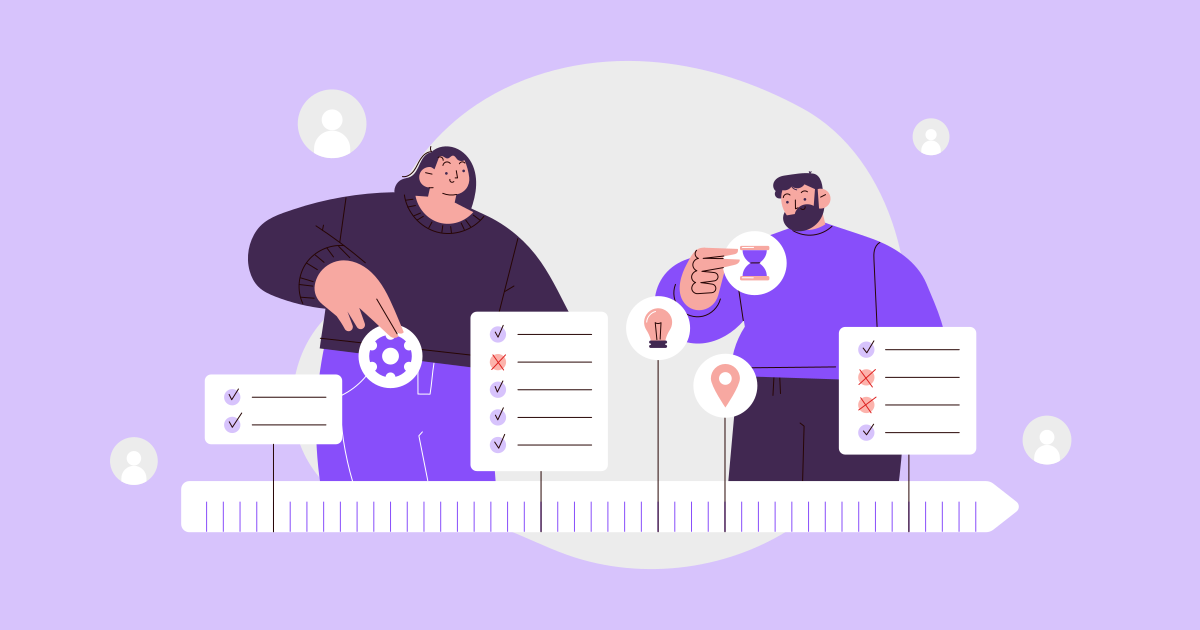Table of content
Prospecting some days feels like yelling “buy now” into space. You send 50 cold emails, make 20 calls, and if you’re lucky, maybe one person replies… asking to unsubscribe.
But inbound prospecting? That’s a different game. It’s the sweet spot where leads actually want to hear from you. They read your blog, download your guide, or binge your videos—and suddenly, you’re not chasing them. They’re already halfway through the door.
Sounds like magic, right? It’s not. It’s strategy, timing, and knowing exactly what your buyers need before they ask for it.
In this guide, we’ll break down how inbound prospecting really works in 2026, why it still matters in a world full of cold outreach, and how to turn that “just browsing” traffic into booked meetings without being pushy or awkward.
Ready to stop begging for attention and start attracting leads that actually convert? Let’s get into it.
What Is Inbound Prospecting?
Inbound prospecting is a sales strategy where leads come to you. Instead of cold calling or sending unsolicited cold emails, you attract potential buyers through valuable content. The goal is simple—earn attention, build trust, and convert interest into qualified leads.
This approach relies on what the buyer needs, not what you want to sell. You create blogs, guides, case studies, or videos that answer real problems your prospects face. When done right, prospects engage on their own—by signing up, downloading a resource, or requesting a demo.
Unlike outbound prospecting, where you reach out first, inbound flips the script. Your content and digital presence do the heavy lifting. It's permission-based and focused on long-term relationships, not quick wins.
Inbound prospecting works best when paired with tools like lead scoring, CRM tracking, and behavior-based segmentation. It helps your sales team focus only on leads who are already warm and ready to talk.
How Inbound Prospecting Works
Inbound sales prospecting is a step-by-step process designed to attract, engage, and convert high-intent leads. It focuses on delivering value at each stage of the buyer’s journey. Here’s how it works:

1. Attract the Right Audience
Everything starts with visibility. To attract quality leads, you need content that answers real questions. This includes SEO-optimized blog posts, helpful videos, free tools, and downloadable resources.
Use search engine optimization (SEO) to rank for terms your buyers are already searching. Leverage social media and webinars to build trust and show your expertise. The goal here is not just to drive traffic—but to draw in the right kind of traffic that matches your ideal customer profile (ICP).
This step sets the tone. If you attract the wrong audience, the rest of the funnel breaks.
2. Engage with Context and Value
Once a visitor shows interest—by signing up, downloading something, or spending time on your site—engagement begins. But it has to be relevant.
Personalized emails, smart automation, and follow-up content tailored to their behavior help deepen the connection. You’re not selling yet—you’re helping them solve a problem. Educational content like how-to guides, product comparisons, and use cases work well here.
This is where lead nurturing takes place. Use a CRM to track touchpoints and segment leads based on behavior, pain points, and buying stage.
3. Convert with Trust, Not Pressure
Conversion in inbound sales doesn’t mean a hard close. It means helping the lead arrive at a decision with confidence.
Address their objections before they bring them up. Offer free trials, live demos, or customer stories that show real results. The key is to stay consultative. You’re not pushing the sale—you’re making the next step obvious and easy.
High-converting inbound strategies often involve sales and marketing alignment. When both teams understand what makes a lead "sales-ready," the handoff is smooth and the close rate improves.
Key Components of Inbound Prospecting
Successful inbound prospecting relies on a few core elements working together. Each one helps bring the right leads closer to a buying decision—without pressure or cold outreach.
1. Content That Solves Real Problems
Great inbound starts with content that helps, not sells. Think blog posts, eBooks, videos, and webinars that answer real questions your prospects ask every day.
If someone is searching for a solution, your content should be what they find. Cover pain points, offer practical advice, and give them a reason to keep coming back. This builds trust before a conversation even starts.
2. Visibility Through SEO and Social Proof
You can’t help people if they can’t find you. That’s where SEO and social media come in.
Use keyword research to create content that ranks in search engines. Then, share it on the platforms your buyers use—LinkedIn, YouTube, or even niche communities. It’s not just about being present; it’s about being useful and consistent wherever your audience hangs out.
3. Lead Magnets That Offer Real Value
Want your visitors to take action? Give them something worth exchanging their email for.
Lead magnets like free trials, checklists, templates, or whitepapers work well—if they solve a specific problem. Pair these with clean, focused landing pages that make the offer clear and the next step easy.
A strong lead magnet doesn’t just get contact info—it attracts buyers who are already interested in what you do.
4. Smart, Personalized Follow-Ups
Once you’ve got the lead, don’t go silent. But don’t go generic either.
Use email sequences that feel personal, not automated. Offer more useful content, answer common objections, and keep the tone friendly. Track what they open, click, or ignore. Then adjust your follow-up based on their behavior.
This kind of lead nurturing keeps your brand top of mind and builds trust over time—so when they’re ready to buy, they come to you.
The Real Difference Between Inbound and Outbound Prospecting
Not all prospecting strategies work the same. Some sales teams thrive with inbound leads. Others rely on outbound prospecting efforts to hit targets fast. The truth? Both can work—if you understand when and how to use them.
Here’s a clear, side-by-side breakdown to help you decide which approach fits your sales motion best:
Both strategies have a place. The best sales teams know how to balance them—using inbound to build trust and outbound to create momentum.
Benefits of Inbound Prospecting
Inbound prospecting isn’t just about saving time—it’s about building smarter, more sustainable pipelines. When done right, it brings better leads, stronger relationships, and long-term growth without the hard sell.

1) Attracts More Qualified Leads
People who engage with your content are already searching for a solution. They’re curious, informed, and often closer to making a decision. That means you spend less time chasing and more time closing.
2) Builds Trust and Thought Leadership
When you consistently share helpful, relevant content, prospects begin to see you as more than a vendor. You become a trusted resource. This trust turns into higher response rates, better conversations, and deals that stick.
3) Lowers Cost per Acquisition
Instead of paying for cold outreach tools or ad campaigns, inbound relies on evergreen assets—like blogs, videos, and lead magnets—that work for you around the clock. Over time, your cost to acquire a customer drops significantly.
4) Scales Without Burnout
With the right setup, inbound prospecting runs on autopilot. Content keeps pulling in traffic. Email workflows handle follow-ups. Your team can focus on real conversations, not repetitive tasks.
5) Powers Better Personalization
Every click, download, or page view tells a story. With the data from inbound actions, you can segment your audience and tailor messages that actually resonate—making your outreach feel relevant, not random.
Modern Inbound Prospecting Strategies That Work in 2026
Inbound prospecting has evolved. Buyers today are smarter, more skeptical, and less likely to fall for generic content. If you want results in 2026, you need to shift from basic blog posts to targeted, experience-driven strategies.
Here are the methods top sales teams are using right now:

1. Create Hyper-Specific Content Hubs
One-size-fits-all blogs don’t cut it anymore. Instead, build niche content hubs focused on your ideal customer’s pain points. Think industry-specific guides, comparison pages, or problem-based video series.
If your buyers are in healthcare tech, don’t write generic sales tips. Talk about data compliance, patient onboarding, or HIPAA-safe CRM solutions. Speak their language.
2. Use Intent Data to Prioritize Prospects
Not all website visitors are equal. Tools that track behavior—like content viewed, time on page, or forms filled—help you spot who’s actually interested.
Pair this with lead scoring. Focus on prospects who’ve taken high-intent actions like watching a demo or reading pricing pages. It’s smarter, not harder, prospecting.
3. Mix SEO with Thought Leadership
Ranking on Google is still vital—but ranking alone isn’t enough. In 2026, buyers want proof you know what you're talking about.
Blend keyword-optimized content with your team’s real voice. Share expert takes on LinkedIn, co-author blogs with sales leaders, or turn client Q&As into content. Show you’re in the trenches—not just quoting stats.
4. Personalize at Scale with Smart Automation
Automation has matured. With tools like dynamic email fields, behavior-triggered sequences, and CRM-integrated outreach, you can personalize without losing time.
Don’t send the same email to every lead. Tailor follow-ups based on actions—like “Hey, I saw you downloaded our onboarding checklist for remote teams…” That small detail makes all the difference.
5. Leverage Interactive Content
Static content is easy to ignore. Interactive content keeps people engaged and gives you better signals.
Quizzes, calculators, product recommendation tools, or self-assessment checklists not only add value—they capture data. That data helps your reps follow up with clarity and purpose.
6. Align Sales and Marketing from Day One
Inbound dies when marketing and sales don’t talk. In 2026, successful prospecting means both teams know what a qualified lead looks like and work together on messaging, timing, and content strategy.
Run monthly alignment check-ins. Share feedback loops. Use insights from calls to update landing pages. When everyone’s in sync, leads convert faster.
Also Read: Sales Prospecting vs Lead Generation
Why Inbound Prospecting Is the New Power Play in B2B Sales
Inbound prospecting isn’t just a different tactic—it’s a shift in power. In traditional B2B prospecting, the seller controls the message. But in inbound, the buyer is in charge. They research. They evaluate. And they decide when to engage.
That’s not a threat. It’s your biggest opportunity.
Inbound lets you meet buyers at the exact moment they’re looking for help. No pushing. No interrupting. Just showing up with value—when and where it matters.
1. Every Click Builds Your Prospecting List
Think beyond static lead forms. Every time someone reads a blog, watches a demo, or engages with a LinkedIn post, they’re telling you something. That’s behavioral intent. Smart teams use this data to build a prospecting list that’s driven by signals, not guesswork.
These aren’t cold leads—they’re already warmed by your content. That’s the foundation of a high-converting pipeline.
2. Your Best Prospecting Tool Is the Content You Already Own
You don’t need to buy another tool to get better at prospecting. Often, the best prospecting tool is your own expertise, packaged into high-value content. A case study. A benchmark report. A simple, well-structured guide.
But the trick isn’t just publishing it—it’s aligning it with the right audience and intent. Use automation to serve the right asset at the right time. Let your content do the qualifying while your sales team focuses on closing.
3. LinkedIn Prospecting Isn’t Cold—It’s Contextual
Most reps use LinkedIn prospecting to reach out. The best reps use it to build context.
When a lead comes in through your website or content, LinkedIn becomes a research layer. You can see who they are, what they care about, and who they follow. Then, tailor your outreach with real insight—not just personalization tokens.
That’s what turns inbound interest into real conversations.
Best Practices (and Real-World Challenges) in Inbound Prospecting
Inbound prospecting works—if you do it right. It’s less about chasing and more about showing up with the right value at the right time. Here are the best practices to follow and the common bumps you’ll hit along the way (plus how to handle them like a pro).
What Works (Your Inbound Playbook)
- Know who you're talking to: Create buyer personas like you’re casting a movie. Who are they? What do they care about? Build your content and outreach around their problems—not your product.
- Deliver value first: Before you pitch, teach. Share tips, solve a problem, give away something useful. Help them win a small battle before asking them to join your war.
- Make it personal: Mention what they read, downloaded, or clicked. Refer to their job or company. Ditch the “Hi there” template. Your prospects can smell a generic email from a mile away.
- Follow up fast: Speed closes deals. When a lead shows interest, don’t wait. The faster you reply, the more likely they are to remember who you are—and care.
- Track and improve: Keep an eye on what’s working. Which content brings leads? Which emails get replies? Use that data to sharpen your strategy. Prospecting isn’t guesswork—it’s pattern recognition.
What Gets in the Way (And How to Handle It)
- Inbound takes time: You won’t see a flood of leads overnight. Inbound is a slow build. Start early, stay consistent, and trust the process. Think long game, not quick hit.
- Too much content noise: Everyone’s publishing. So stand out with your voice. Share real stories, use fresh formats, and speak to one audience clearly. Clarity beats cleverness.
- Not all leads are ready: Just because someone downloads your checklist doesn’t mean they want a demo tomorrow. Use lead scoring and nurture workflows. Stay patient. The best leads close when they’re ready—not when you want them to.
Inbound Alone Won’t Cut It. SMARTe Helps You Cover Both Sides of the Funnel
Inbound leads are great—when they come in. But let’s face it, they don’t always show up on time. Some days your CRM’s buzzing. Other days, it’s a ghost town.
That’s why the best prospecting teams don’t wait around. They mix inbound with outbound to keep pipeline steady and deals moving. SMARTe helps you do both with one reliable data engine.
Whether a lead finds you or your rep finds them, SMARTe gives your GTM team the fuel to take action:
- Access to 281M+ clean, verified B2B contacts
- Firmographic and technographic filters to zero in on the right accounts
- Accurate direct dials and mobile numbers to skip the gatekeepers
- Enrichment tools that fill in the gaps once leads are in your system
No more chasing bad data. No more wasting time on the wrong accounts. SMARTe helps you follow up faster, prospect smarter, and focus on the people who actually matter.
Inbound or outbound—real prospecting takes both.
Book a demo today and see how SMARTe helps your team build pipeline that doesn’t stall.









